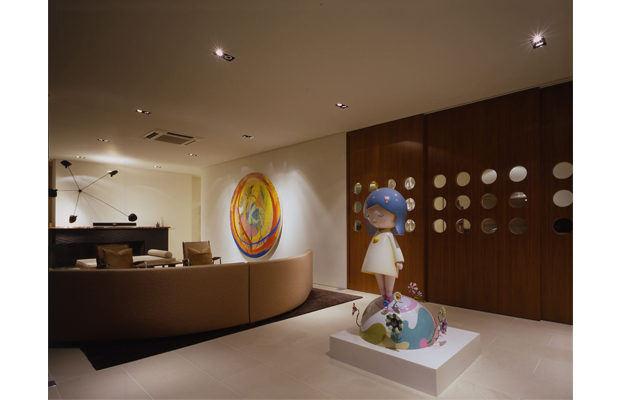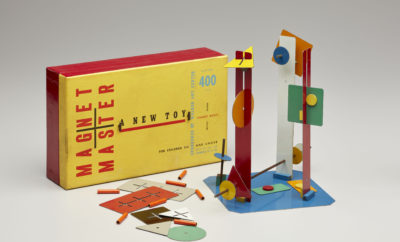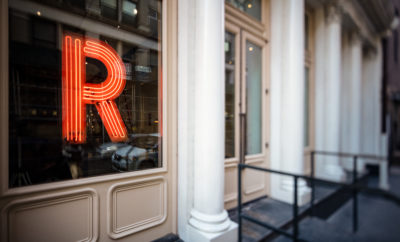
Design
All in the Family

The living room seen through the floor-to-ceiling glass walls. A five-armed Serge Mouille lighting unit is strikingly mounted above the fireplace while a Damien Hirst spin-art tondo brightens one wall and an Alexander Calder stabile stands on a George Nakashima low table. The seating area is anchored by a Jean Royère sofa and stool and two Nakashima tables.
All in the Family:
A house in Seoul, South Korea, manifests a lively and happy marriage of modernisms
Jaewoong Chung is perplexed by art collectors who pair their contemporary works with current day furniture. “I walk into these Park Avenue apartments filled with Warhols and Damien Hirsts—and furnished with B&B Italia,” he says, shaking his head. “But to me, it makes more sense to place cutting-edge art alongside vintage modernist pieces: Jean Prouvé, Charlotte Perriand, George Nakashima.” You could chalk up his sentiment to bias: Chung is a private furniture dealer and interior designer whose New York firm, Vintage 20, specializes in works by the aforementioned heavy hitters. He also runs an art gallery with his wife, Tina Kim, and they represent of-the-moment stars like Ghada Amer and Marc Andre Robinson.
But Chung references historical precedent—and conceptual congruity—for his pairing preferences. “Flip through the archival photographs in Patrick Seguin’s Prouvé monograph and you’ll see that collectors always mixed his pieces with contemporary art.” He notes that designers like Perriand and Pierre Jeanneret were forward thinking in their day, engineering factory-made pieces during the heyday of art deco, which drew from classicism and emphasized handcraftsmanship. “Prouvé in particular questioned why furniture needed to be so serious, so precious. In this way, he had a lot in common with pop artists like Warhol, who was among the first to joke with art. The underlying ideas are the same.”
A convincing argument for the comingling of modern-day art and mid-century modern furnishings is a house Chung designed for his wife’s parents in Seoul, South Korea. His mother-in-law, Lee Hyun-Sook, is the founder of Kukje Gallery, whose program promotes native talents like Lee Bul and Bohnchang Koo alongside Anselm Reyle, Joseph Beuys, Candida Höfer, and other international stars. She had also amassed a trove of gems by Nakashima, Prouvé, Émile-Jacques Ruhlmann, and Jean Royère—primarily with the help of her son-in-law, who guest curates design exhibitions in her gallery once a year. Chung was an obvious choice for the decorating job, and not just because of their professional collaboration: “When it came to designing her house,” he recalls, “she told me, ‘Jae, nobody understands our lifestyle as well as you do.’ Tina and I met as undergraduates in the early 1990s, so I’ve been hanging out with her family—and in their houses—for over twenty years.”
In fact, he reworked the existing layout of the property to channel the architecture of Mies van der Rohe as well as that of Tina’s modernist childhood home in Southern California. “Everyone in the family loved that house,” says Chung. “So I re-created a scaled down version of it in Seoul that answers how they live today.” Walls were demolished to establish an open plan suited to the display of large-scale artworks. In the living and dining areas, floor-to-ceiling glass walls overlook plantings, establishing a lush modern vibe. Creamy stone floors extend past the glazing to further smudge the boundary between indoors and out, making the space feel like the pedestal that it is.
Dividing the main floor is a series of sliding walnut panels pierced with round windows, a design inspired by the porthole-dotted prefab walls of Prouvé’s Maison Tropicale. The full-height panels reconfigure the free flowing space as desired, closing off the living room from the stainless-steel kitchen and entry corridor to carve out a more intimate space for enjoying art. The doors also serve as a rich yet neutral backdrop for assertive pieces like a Takashi Murakami sculpture and a Damien Hirst spin-art canvas, warming up the otherwise gallerylike envelope of white walls.
Furnishings hold their own against a rotating mix of works by Willem de Kooning, Anish Kapoor, Warhol, Joan Mitchell, and other blue chip names. The bench greeting guests at the entry and an aluminum-fronted 1950s wardrobe cabinet in the main corridor are both by Prouvé. A Charlotte Perriand cabinet topped with Georges Jouve ceramics faces off against an oversized Anselm Kiefer canvas in the dining room. Above the living room’s wraparound hearth—where a painting would normally hang—is a five-arm Serge Mouille lighting fixture. A nearby seating arrangement is anchored by a curvaceous Jean Royère sofa and three-legged stool, plus a pair of Nakashima freeform-edge coffee tables, the smaller displaying an Alexander Calder stabile. It’s a veritable hit list of modernist masterpieces. Says Chung, “I tell all my clients: Just touch the best.”
Chung laughingly admits that he himself could have used this advice when he started collecting in the late 1990s. “Everything I bought before 2001 was junk: $200,000 of C-class Prouvé. It was a good lesson!” He’s since proved a quick study, becoming an expert on Prouvé’s work and introducing it to a Korean clientele through Kukje. One of the best lessons he’s learned along the way, though, has nothing to do with identifying rare prototypes and original finishes; it’s to not treat vintage pieces too preciously. “I often buy in the Congo, where Prouvé had a lot of private commissions,” he explains. “The generation who now owns those pieces often doesn’t realize what they have on their hands.” He discovered one family using a slate table as a stepping stone over a water feature; another used a painted aluminum Tropical Cité table as a chopping board. “It just added to the character,” Chung laughs. “What I love about Prouvé is that every piece has a story to it.












